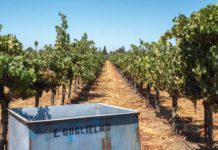How much garlic do you want with that?
That was one question Emeryville artist Scott Donahue had to answer before he started the sculpture called Garlicgeese that welcomes visitors to Gilroy on the west side of Monterey Road a few blocks from the entrance to Hwy. 101.
It’s hard to resist the vegetable that’s put Gilroy on the map, but he, along with the developer the arts commission wanted something a bit less garlicky.
Thus was born Garlicgeese (one word, says the artist), a statue of a mother and her five half-garlic, half-goose creatures sculpted from brass, epoxy and stainless steel, weighing 500 pounds and mounted on a 20-foot-long concrete platform. It’s put smiles on the faces of children and been the site of an international geocache contest, where contestants flocked to find a hidden message.
“Public art is specific to a place unlike art in a gallery,” said Donahue. “Originally, we thought, garlic and Gilroy. But then we thought, maybe people in Gilroy will think they’ve seen enough garlic. I thought if I could do something a little different, a little extra, I thought the general public would like a different presentation. This is our place, but it’s open to interpretation.”
The geese, which cost $50,000, are a sign of the times as Gilroy ponders how to handle public art. Everyone wants art, but few can agree on the merits of individual pieces, or how they should be paid for.
L. Mattock Scariot, the chair of the city’s Arts and Culture Commission, said she’d like to see new developers pay a fee for art to decorate their projects. However, she said, a proposal to charge in Gilroy is on hold while the city awaits the results of a developer’s lawsuit against the city of Oakland for trying the same thing.
Gilroy’s new proposed General Plan, which will be heard by the council Jan. 4 and outlines the city’s intent for its future, lists public art as a priority and suggests finding funding sources that include corporate sponsorships, joint use agreements, private donations, user fees, bonds or fees on new developments.
The downtown is decorated with four historical sculptures that cost $83,000 and were paid for in 2009 by a mix of city funds and private donations.
Planners have placed requirements on some new developers to add art to their projects. The geese were paid for by K. Hovnanian Homes, which built the 60-unit Monterey Manor community on Monterey Road. They were unveiled a year ago.
Donahue, the artist, was considering something about garlic but wanted to add something more. A former employee at the home builder suggested a theme of ducks, based on a statue he’d seen in Boston. Donahue took off with it.
“I was thinking about marching garlics,” said Donahue, who got so into government policies as a public artist that he ran for city council in Emeryville and was elected. He’s now the city’s vice mayor.
But the developer wanted to add something that wasn’t just garlic. And there was some feeling on the city’s art commission that the city needs to include other themes.
“This is how public art works,” said Donahue. “If an artist is just slavishly going to one idea, they can’t make it something better.”
The process took months of review by two city art committees, the planning department and finally the city council, before it was approved. Then it took five months to build. Donahue kept refining the piece, modeling it in clay, long before he used the permanent materials.
The 64-year-old artist and UC-Berkeley lecturer has seen his share of controversy. His Berkeley Big People sculpture on a pedestrian bridge over Hwy. 80 is loved and hated. A review in SF Gate said it “fails every test” in sculpture and criticized the image of campus protesters as being “politically correct.”
Garlicgeese has less controversy. Reviews on the Dispatch’s Facebook page were all positive.
“So creative, simple and beautiful! Well done and thank you mystery artist,” wrote Barb Beaumont Siordia.
Added Scarriot, the arts commissioner: “A lot of people think we have too much garlic. I don’t think so. I love how it’s abstract. You can’t tell it’s geese and it’s garlic. It’s really, really good.”
“It’s a great way to be welcomed to Gilroy,” said city planner Melissa Durkin, who is working with other new art projects on Hecker Pass.













